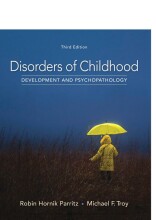Summary: Samenvatting Disorders Of Childhood: Development Psychopathology
- This + 400k other summaries
- A unique study and practice tool
- Never study anything twice again
- Get the grades you hope for
- 100% sure, 100% understanding
Read the summary and the most important questions on Samenvatting Disorders of Childhood: Development Psychopathology
-
1 Development & Psychopathology
This is a preview. There are 1 more flashcards available for chapter 1
Show more cards here -
What does developmental psychopathology emphasize?
Maladaptive patterns and disorders occur in the context of typical development. Look at the strenghts and weaknesses as kids experience age-related challenges. -
What are some barriers to care?
- Structural barriers (no money, long waiting lists)
- Perceptions of mental health (fear, shame)
- Perceptions of mental health services (negative experiences) -
What are the dimensions of stigma and their targets?
Dimensions: stereotypes, devaluation and discrimination.
Targets: the individual, the family. -
1.1 What is normal or abnormal?
This is a preview. There are 1 more flashcards available for chapter 1.1
Show more cards here -
What influences the views on what's normal or abnormal? Explain them.
- Statistical deviance (you have an disorder at the edge's of behavior, too good or too bad).
- Sociocultural norms (disorder when failing to conform to expectations).
- Mental health perspectives (disorder based on theoretical/clinical based notions of distress and dysfunction, quality of life is key). -
Developmental epidemiology: what does incidence mean?
Rate at which new cases arise (all new cases in a given time period). -
4 key points that illustrate that adaption is an ongoing activity?
1. Development is cumulative (optellend)
2. Developmental pathways are probabilistic (willekeurig)
3. Change is possible at many points
4. Change is constrained or enabled by previous adaptions -
1.2 Historical models of looking at psychopathology
This is a preview. There are 6 more flashcards available for chapter 1.2
Show more cards here -
What is the vision of dimensional models?
Typical feelings/thoughts gradually become problems which mayworsen to becomedisorders . -
What is the vision of categorical models?
Discrete and qualitative differences in individual patterns of emotion/cognition/behavior. -
What are the physiological models about?
There is aphysiological (genetic,structural , biological or chemical) basis for all psychological processes. Believe in gene-by-environment effects and brain plasticity. -
What is the diathesis-stress model about (physiological model)?
(genetic) predispositions in combination with additional stress lead to the emergence of a disorder, not structural differences in and of itself.
- Higher grades + faster learning
- Never study anything twice
- 100% sure, 100% understanding
Topics related to Summary: Samenvatting Disorders Of Childhood: Development Psychopathology
-
Development & Psychopathology - Historical models of looking at psychopathology
-
Development & Psychopathology - Adaption & pathways
-
Attachment & Relationships - Attachment
-
Attachment & Relationships - Relationships
-
Disorders of early childhood
-
Autism Spectrum Disorder - Characteristics
-
Autism Spectrum Disorder - Theories on etiology
-
Autism Spectrum Disorder - Treatments
































